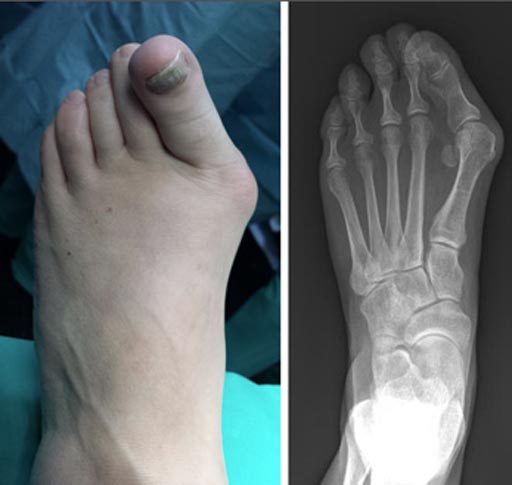Post-Surgical X-Rays Predict Bunion Recurrence Risk
By MedImaging International staff writers
Posted on 10 Aug 2017
Measuring the hallux valgus angle (HVA) on postoperative x-rays immediately following bunion surgery can reliably predict satisfactory correction and risk of recurrence.Posted on 10 Aug 2017
Researchers at Yeungnam University (Daegu, South Korea) and Injie University Seoul Paik Hospital (Republic of Korea) conducted a study in 93 patients (for a total of 117 feet) who underwent proximal chevron osteotomy combined with a distal soft-tissue procedure in order to treat moderate to severe hallux valgus deformity. Changes in hallux valgus angle, inter-metatarsal angle, and sesamoid position over time were analyzed by comparing non-weight-bearing radiographs during each postoperative period.

Image: The clinical and radiographic appearance of a bunion (Photo courtesy of AAOS).
The relative risks of recurrence, as indicated by preoperative and postoperative radiographic parameters were then determined. The results showed that hallux valgus angle and inter-metatarsal angle stabilized at six months after surgery in the nonrecurrence group. Hallux valgus recurrence was associated with an immediate postoperative hallux valgus angle higher than 8°, immediate postoperative sesamoid position of grade 4 or greater, a preoperative metatarsus adductus angle of 23° or higher, and a preoperative hallux valgus angle of higher than 40°. The study was published in the July 2017 issue of The Journal of Bone and Joint Surgery.
“Bunions were 28 times more likely to recur when the postoperative HVA was eight degrees or larger than when the HVA was less than eight degrees. The HVA continued to widen over time in patients with recurrent bunions, but stabilized at six months in those without recurrence,” concluded study authors Chul Hyun Park, MD, PhD, and Woo-Chun Lee, MD, PhD. “The recurrence of hallux valgus is one of the most important complications after surgery because it is closely related to patient satisfaction.”
A bunion is a painful bony bump that develops when the metatarsophalangeal (MTP) joints move out of alignment: the long metatarsal bone shifts toward the inside of the foot, and the phalanx bones of the big toe angle toward the second toe. The MTP joint gets larger and protrudes from the inside of the forefoot. The enlarged joint is often inflamed, red, and swollen. The word bunion, in fact, comes from the Greek word for turnip, hinting to its appearance.
Related Links:
Yeungnam University
Injie University Seoul Paik Hospital








 Guided Devices.jpg)





